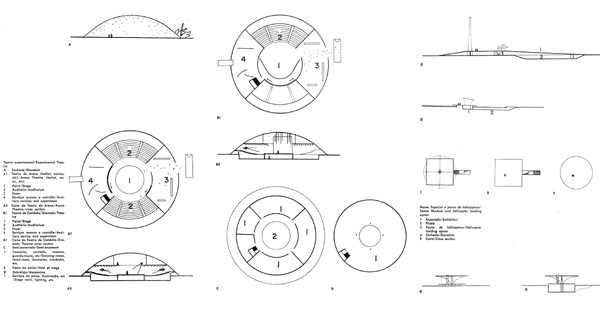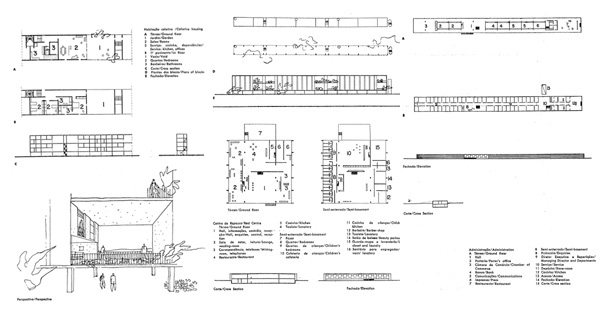COLUMNS
360º Architecture
29 May, 2010
Oscar Niemeyer’s Permanent International Fair in Tripoli
Lebanon's Unfettered Market-Driven Development Poses a Threat to the Country's Architectural Heritage and Urban Public Space.
Oscar Niemeyer's fashion status was confirmed in 2000, when the Italian fashion house Prada threw a glamorous all-night party at the French Communist Party Headquarters, designed by Niemeyer (Paris, 1967-80, inaugurated in 1971), to celebrate the opening of its new boutique at the faubourg Saint-Honoré and the launch of its new Miu Miu line. Young fashion designers like Roksanda Ilincic claim influence from the Brazilian architect and at times Niemeyer's spectacular buildings are almost literally translated into dresses. Last January, the Belgian designer Dries Van Noten chose to present his autumn/winter men's collection in the same building, which he thought perfectly suitable for his 'fantômes-garçons' with their 'serious, pre-Cold-War look, inspired by the 1950s'. In 2007, the Lebanese pop-icon Haifa Wehbe starred in a commercial advertisement for Pepsi, staged on the grounds of the Rashid Karami International Fair complex in the historic city of Tripoli, Lebanon (formerly Permanent International Fair, 1962-74, partially completed), a major work of Oscar Niemeyer (1907-) with a turbulent history and currently in danger. In spite of the iconic status, popularity and worldwide acclaim of Niemeyer's architecture, today's Lebanese politicians appear indifferent to the historic significance of Tripoli's Modernist heritage, and unwilling to invest in the fair's potential as a public good in order to guarantee its integration in the daily life of its citizens.

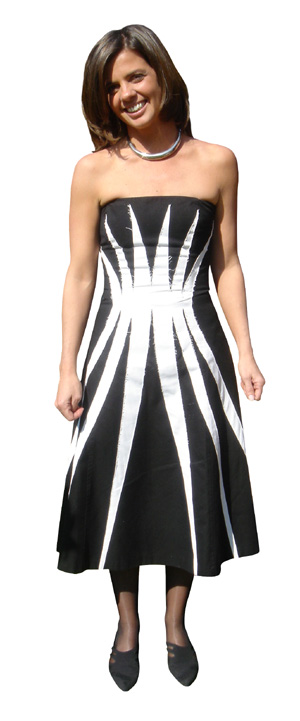
Roksanda Ilincic, autumn/winter 2008 collection, left; designer dress featuring Oscar Niemeyer's Brasília Cathedral, right
Commercial advertisement for Pepsi starring Haifa Wehbe, staged in Oscar Niemeyer's Permanent International Fair in Tripoli, Lebanon
The Permanent International Fair of Tripoli was a bold and ambitious project typical of the period of the Welfare State, roughly from the late 1950s to the late 1960s, including the 'good times' of President Fuad Shihab's era (1958-67) that followed the 'crisis of 1958'. It was a period characterized by intense urbanization and modernization, administrative reform, political and institutional organization, considerable industrial development, a rapidly expanding and rationalized economy, markedly increased government expenditure, growing investment in education and significant social service improvements, and a 425 percent increase in public works. The inception of the Permanent International Fair for Lebanon's second-largest city was commensurate with the Welfare State's 'strong public sector involvement in all matters of building, public works, and civic projects...big plans, comprehensive concepts and infrastructure improvements on a large scale'. The current threat to the fair's civic role, its integrity and preservation is a consequence of today's 'era of privatization' and conspicuous lack of comprehensive civic visions. Today's commercial-interest-led urban projects are characterized by sharply contrasting attitudes towards public good and the socio-political issues involved in the production, use and transformation of urban public space.(1)
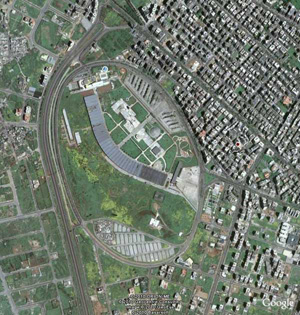

Oscar Niemeyer, Permanent International Fair, Tripoli (1962-74, partially completed, renamed Rashid Karami International Fair), Google Earth image, left, Oscar Niemeyer, Permanent International Fair, Tripoli, site plan, right
In 1962, the Brazilian ambassador Bolivar de Freitas invited Oscar Niemeyer, on behalf of the Lebanese government, to design the Permanent International Fair complex for the city of Tripoli. Niemeyer criticized the process that led to the selection of the site, arguing that it should have been preceded by in-depth study of the urbanization of the region in order to guarantee the organic integration of the fair with the future expansion of the city. He would have also preferred a coastal site. His proposal put forward an entire new city quarter, with the fair as its focal point, accommodating a culture and leisure programme. Between the fair and the sea coast he proposed zones for housing, commerce, sports, entertainment and tourism - the latter forming a link between the fair and the sea - paying particular attention to the problem of housing, which he saw as being debased and subjected to commercial interests.(2)
For the fair itself, Niemeyer 'rejected the common typology, repeated all over the world, with isolated pavilions', and 'returned to the ideas of nineteenth-century expositions'. His team proposed a 750 x 70 metres flat canopy - curved in plan - that would guarantee 'plastic discipline and unity'.(3) The pavilions of the various countries would be arranged under this 'single roof...economic and speedily built' and in the 'spirit of a pavilion...a mere shell to encase the exhibits'. This reinforced-concrete canopy of 'grandeur and simplicity' created a shaded space for leisurely promenade and was offset by a string of various reinforced-concrete forms amid verdant gardens, arranged opposite its concave side and linked together by 30,000 square metres of water pools. These structures clearly demonstrate Niemeyer's consistent pursuit of the full integration of structure, spatial and formal concept. Most prominent among them - 'in a commanding position' - is the Museum of Lebanon, a square colonnaded pavilion that brings to mind Brasília's Palácio do Itamaraty (Ministry of Foreign Affairs, 1962-70), while its pointed arches clearly reference Tripoli's historic architecture. The Museum of Lebanon is floating in a shallow, reflective pool, Niemeyer's ubiquitous instrument of narcissism that transforms his buildings into flowers conscious of their beauty. To the side of the adjacent large pool, under a white concrete dome is the Experimental Theatre, 'where the most widely varying performances will be staged', surrounded by lush vegetation. In this second pool, the helipad-crowned Space Museum is accessed via a long low bridge that stems from the centre of the curved exhibition pavilion and, further along its route, meets a large ceremonial ramp ascending to the open-air theatre, equipped with an acoustic shell. At the highest point of the ramp, marking the entrance to the theatre's elevated, open-air foyer, stands a smaller, concrete version of Eero Saarinen's Gateway Arch in St Louis, Missouri, counterbalanced by a water tower with a restaurant at its highest point, affording 'a comprehensive view of the whole Fair'.(4)
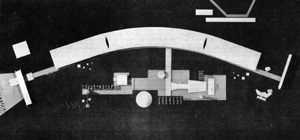
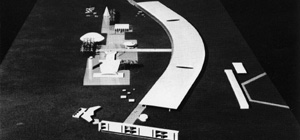
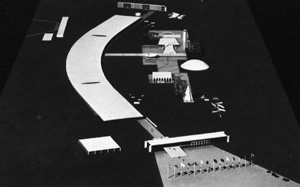
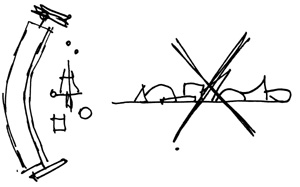
Oscar Niemeyer, Permanent International Fair, Tripoli, photographs of model and preliminary sketch
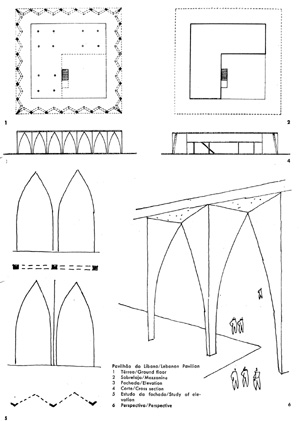
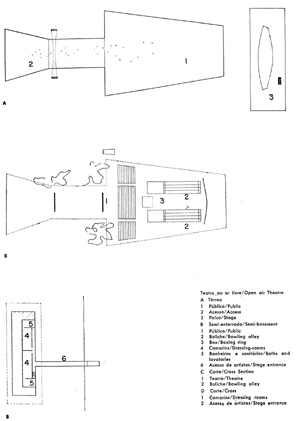
Oscar Niemeyer, Permanent International Fair, Tripoli: Museum of Lebanon, left, and open-air theatre, right
Oscar Niemeyer, Permanent International Fair, Tripoli: Experimental Theatre and Space Museum (click to enlarge)
The main access to the fair is situated at one end of the 'great pavilion'. A vast ramp leads to the entrance portico, where the visitor is welcomed with a sweeping view of the entire complex. The adjoining structure was envisaged by Niemeyer as a 'Rest Centre' with 'lounges, reading-room, restaurant, lavatories, barbershops, beauty parlour and resting room, for the repose and relaxation of the visitors. The portico (reception, control, information and tourist services) marks the public entrance and, in the vein of Brazil's Antropofagist tradition, was conceived by Niemeyer to 'express, by the proportions and width of its spans, the architecture of today, enhanced in its details by the Arab tradition of [Lebanon]'. Between the entrance facilities and the Lebanon Museum, Niemeyer proposed a children's playground (not realized). The Housing Section was positioned at the opposite extreme of the 'great pavilion', closing off the composition. Administration services were accommodated in two separate blocks, parallel to the convex side of the long canopy. The Housing Section included a hotel and the Housing Museum. A little train would run 'all day long' between this point and the entrance portico. The Housing Museum focused on a comparison between collective housing and the individual detached house, for which Niemeyer provided examples. The primary difference between the two, he postulated, is that the former, 'upon which contemporary town-planning is founded [is] simple and built to a module', whereas the latter is characterized by 'plastic unrestraint...justified by the variety and individualization of the programmes'.(5)
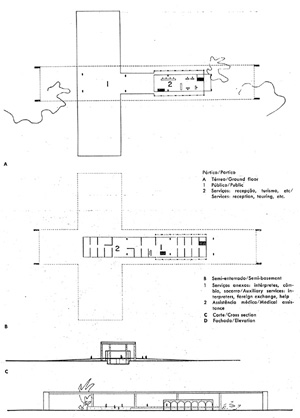
Oscar Niemeyer, Permanent International Fair, Tripoli: entrance portico and Rest Centre
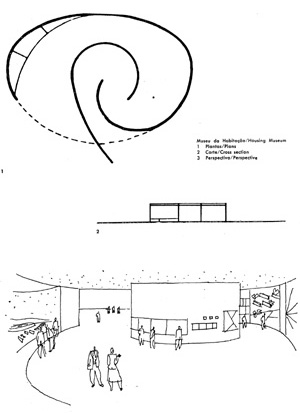
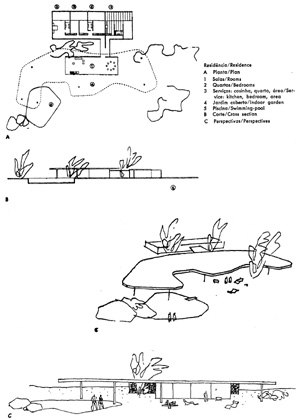
Oscar Niemeyer, Permanent International Fair, Tripoli: Housing Museum, left, and individual detached house, right
Oscar Niemeyer, Permanent International Fair, Tripoli: collective housing (click to enlarge)
A Los Angeles Times dispatch of 1964 from the 'plush playground of the Arab world' read: 'Real estate values have soared as one glass-walled skyscraper after another has risen on the coveted coast in and around Beirut.' It reported on 'oil-rich traders' roaming the capital in 'air-conditioned Cadillacs' and billions of dollars of Kuwaiti and Saudi investments pouring into its 'stable banks' as well as on industrial Tripoli in the north staking its development on 'a world-class international fairground'.(6) The Permanent International Fair was almost complete by 1974. The onset of civil war, the following year, meant that this public site intended for cultural, recreational and commercial uses has never been part of the daily life of Tripoli's citizens. Until the early 1990s, it served as a military base for the Syrian army and, although it suffered destruction, its gardens are well maintained. Yet, the site lies closed off and deserted. A hotel has already been built at one end of the site, but Tripoli's residents are deprived of access to a major and desperately needed public amenity. On a recent visit I was positively surprised to find that the fair's basic structures remain largely intact and it is relatively easy to put the complex to use, realize the potential of the 10,000-hectare site, and allow it to fulfil its role in promoting what Lefebvre defined as the 'right to the city' - that is, returning part of the city's wealth and space to its occupants.
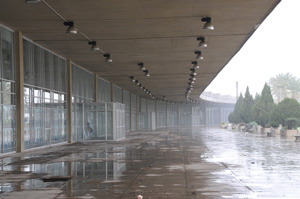
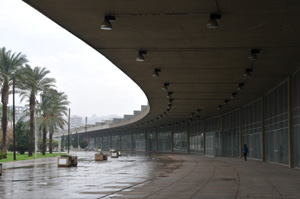
Oscar Niemeyer, Permanent International Fair, Tripoli: 'great pavilion'. Photographs by Styliane Philippou
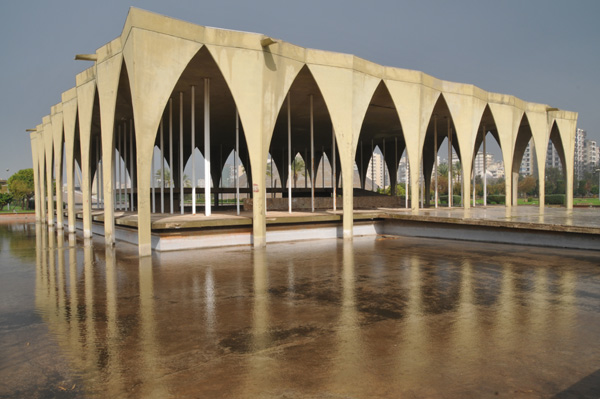
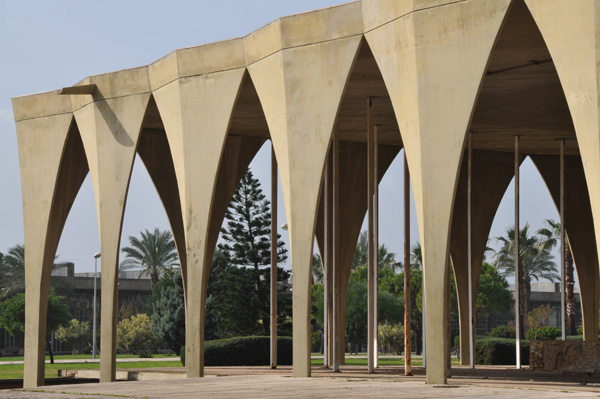
Oscar Niemeyer, Permanent International Fair, Tripoli: Museum of Lebanon. Photographs by Styliane Philippou
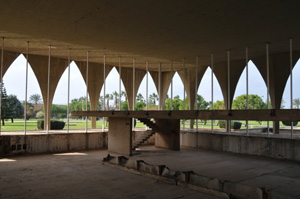
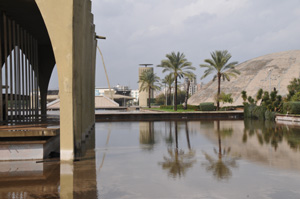
Oscar Niemeyer, Permanent International Fair, Tripoli: Museum of Lebanon with views towards the Experimental Theatre, the ramp leading to the gateway arch and open-air theatre, and the water tower. Photographs by Styliane Philippou
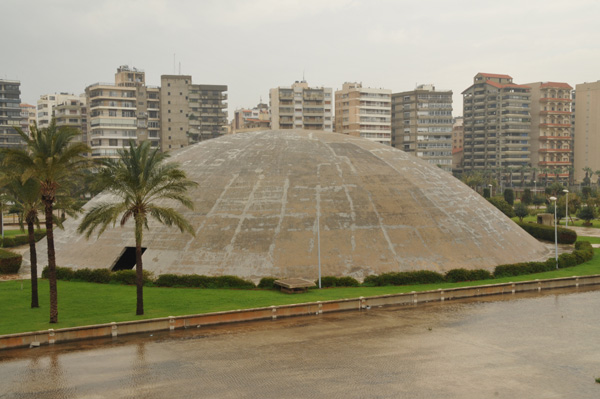
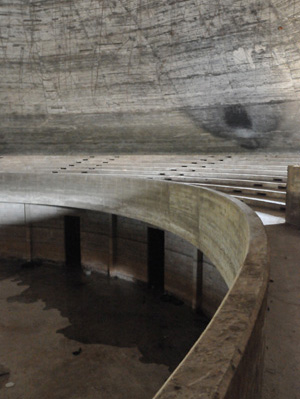

Oscar Niemeyer, Permanent International Fair, Tripoli: Experimental Theatre. Photographs by Styliane Philippou
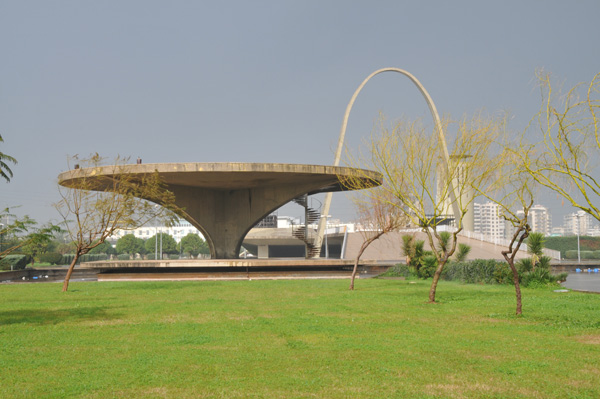
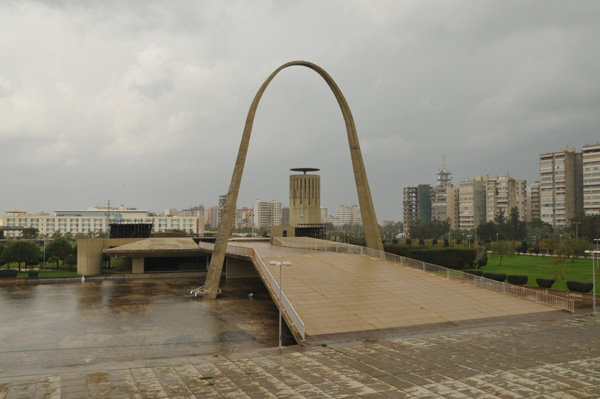
Oscar Niemeyer, Permanent International Fair, Tripoli: Space Museum, left, and ramp and gateway arch leading to open-air theatre, right. Photographs by Styliane Philippou
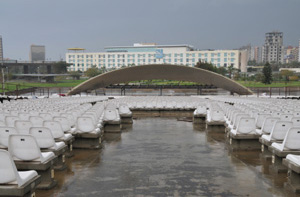
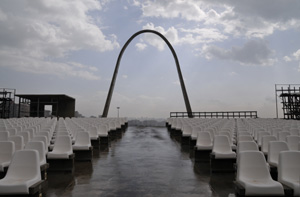
Oscar Niemeyer, Permanent International Fair, Tripoli: open-air theatre with acoustic shell, left, and gateway arch, right. Photographs by Styliane Philippou
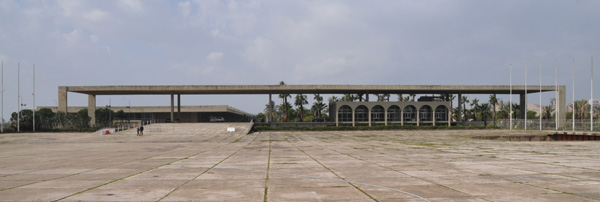
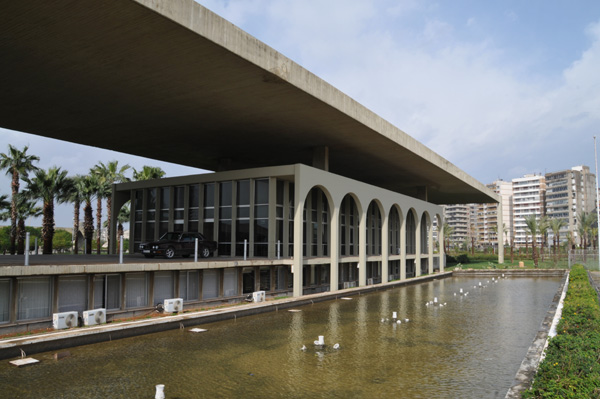
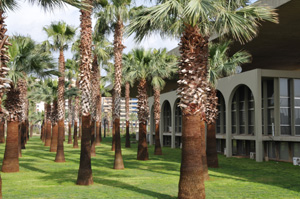
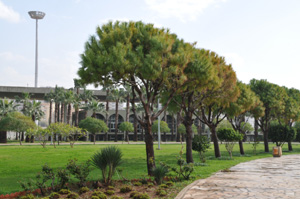
Oscar Niemeyer, Permanent International Fair, Tripoli: entrance portico with Rest Centre. Photographs by Styliane Philippou
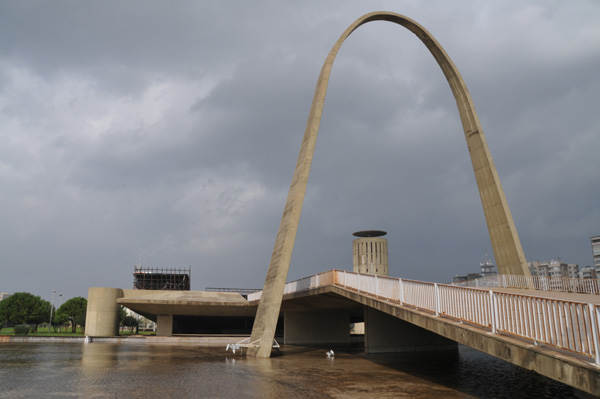
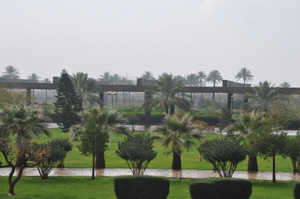
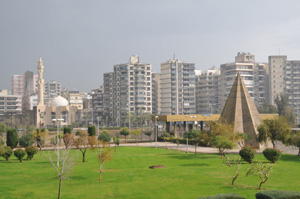
Oscar Niemeyer, Permanent International Fair, Tripoli: views of the various structures amid landscaped gardens and reflective pools. Photographs by Styliane Philippou
At the beginning of 2004, the Chamber of Commerce, Industry and Agriculture of Tripoli and North Lebanon initiated the transformation of the Permanent International Fair into a 'tourist village destined to accommodate millions of visitors a year, based on the model for Disneyland'. Blatantly disrespectful of the project's original intentions and its architecture, the proposed scheme envisaged a 'program...of 60,000 meters sq. meters of exhibition space, 200,000 sq. meters of leisure and recreation space, a 170,000 sq. meter nautical center with pools, three international hotels, a "model Lebanese village" constructed on axis with the Lebanese Pavilion of Niemeyer [with] artisan shops, additional commercial and restaurant spaces, all of which [will] be connected by a "tourist" train'. On 21 June 2005, at a press conference in New York organized by the World Monuments Fund (WMF), it was announced that the Rashid Karami International Fair complex in Tripoli, once the pride of this industrial Lebanese port, was inscribed in the 2006 World Monuments Watch List of 100 Most Endangered Sites. The WMF expressed the hope 'that this listing may serve as a reminder that as Lebanon steadily mends its war-torn landscape, room should be made for sites of architectural importance of the recent as well as the distant past.' The decision was the result of the successful campaign launched in 2004 by Heritage Without Borders and the Lebanese Association for the Protection of Ancient Sites and Residences (Association pour la protection et la sauvegarde des sites et anciennes demeures APSAD).
After the devastating sixteen-year civil war (1975-1990), Lebanon set about repairing its urban fabric and sense of national identity, while trying to tackle the daunting tasks of social and political integration, historic preservation and cultural conservation. But rather than grand plans and urban visions, the emphasis has been on small project areas, under the auspices of private development companies or public-private joint ventures. Most conspicuous among these is the reconstruction of the Beirut Central District (BCD), the historic core of the Lebanese capital, once the country's vibrant centre of administrative, financial and commercial activity, devastated by war and communal strife. Even before the December 1991 legislation that led to the limitation of the role of the state and the handling of responsibility for urban planning and reconstruction to real estate companies, uncontrolled demolitions in the 1980s had ravaged the traditional urban fabric of Beirut's central areas that the Beirut Central District Plan (1977-86) had earmarked for rehabilitation. As a tragic example, the city's old souks were erased.
In 1983, OGER Liban, a private engineering firm owned by businessman Rafiq Hariri (Prime Minister from 1992 to 1998 and again from 2000 until his resignation, in 2004, assassinated in 2005) commissioned a master plan for the reconstruction to the consultancy group Dar Al-Handasah. Hariri was the head of the Lebanese government and architect of Law 117 of 7 December 1991 that led to the limitation of the role of the state and the handling of responsibility for urban planning and reconstruction to real estate companies. Hariri was also a major share holder of the real estate company of Solidere, which 'was entrusted with the implementation of the urban plan [of Beirut Central District] and the promotion, marketing and sale of properties to individual or corporate developers. This entailed the total and uncontrolled privatization of the reconstruction and conservation operations.'(7) Effectively, Solidere was empowered to evict the existing population and deprive them of the right to return to their properties, which disappeared following the corporate developers' dissolution of the mediaeval patterns of property, the decimation of the city's physical fabric and the concomitant elimination of its social fabric.(8) 'In 1993, approximately 80 percent of the structures [in Beirut's Central District] had been damaged beyond repair, whereas only one third had been reduced to such circumstances as a result of damage inflicted during the war itself.'(9)
In 1998, Assem Salam, president of the Order of Engineers and Architects of Beirut, wrote: 'If the destruction of Beirut Central District during fifteen years of civil war has been an agonizing experience for Lebanese citizens, the plan for its reconstruction has exposed them to an intolerable vision of their capital's future. With the battered municipal administration in a state of almost total bankruptcy, it is not hard to see how the plan, which reflects no pressing need, but is a high priority for symbolic reasons, has fallen into the hands of developers with barely disguised commercial interests and political ambitions.' He noted that 'the total and uncontrolled privatization of reconstruction operations' in Beirut's Central District proceeded unabated, despite expressed discontent and 'loud protests from large sectors of the community'. Salam described the grave consequences of the 1991 legislation: 'The two main obstacles to the destruction of the heritage and the memory of the old city have thus been removed, and the town center has become a dead city, an empty field open to the speculative ambitions of developers.'(10) In 2001, Robert Fisk observed: 'A 19th-century photograph of Beirut shows a city of stone walls, arches and a mighty Crusader castle. Every building in the picture has gone.' Echoing Assem Salam, he added: 'Today, Lebanon's millionaires are finishing the work of the civil war gunmen who destroyed so much of the city's heritage.'(11) As I was taking a photograph of an old building in Beirut, few months ago, a passing citizen commented: 'last vestiges of an once-beautiful city'.
Solidere claims an advantage for Beirut in comparison with other regional centres such as Dubai, which lack the historical richness of the Lebanese capital. But its unfettered operations have reduced the city's two-thousand-year history to a picturesque 'Heritage Trail' linking excavated archaeological sites and individual historic building façades, commemorative 'brass medallions' and 'multilingual information panels',(12) depriving selectively, partially and frequently insensitively restored historic monuments of their natural and historically meaningful context, turning beautiful scented gardens into parking lots for rapidly proliferating spa-and-fitness-centre-equipped residential towers aimed at the wealthy Lebanese diaspora and the super rich from the Gulf states and beyond, while vulgarizing traditional forms of cultural expression such as the souks, in the service of international shopping tourism, and commodifying the appearance of historic buildings in the service of themed-environment seeking global property investors. Approached in 1996 by Solidere 'to design the souks' of the city, Rafael Moneo says that his project sought 'an architectural solution that revitalizes the familiar character of a souk while accommodating contemporary needs of shopping and retail'.(13) But Moneo's souks bear no relation to the lively traditional souks Beirut destroyed in the name of an ill-conceived modernization, together with their colourful atmosphere and social mixture. The restored historic buildings of Beirut's Central District have been crowned by outrageous one- to three-storey palatial penthouses with landscaped terraces and swimming pools, laden with kitsch agglomerations of pastiche colonial architectural features.
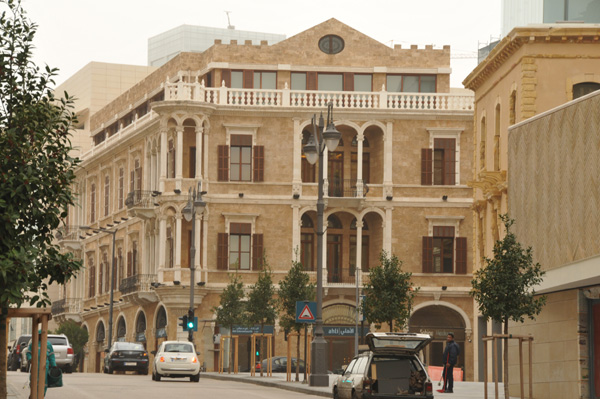
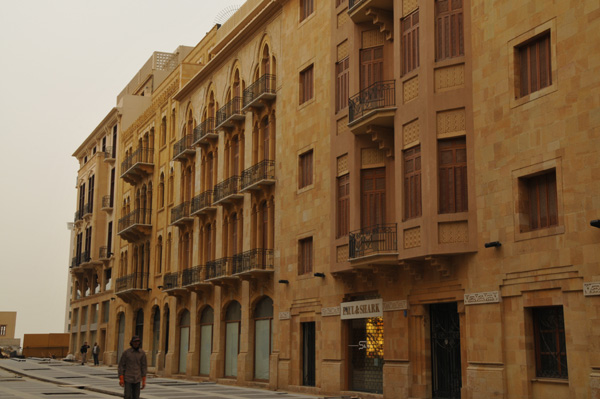
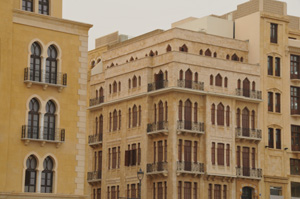
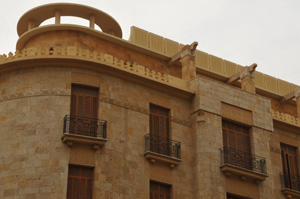
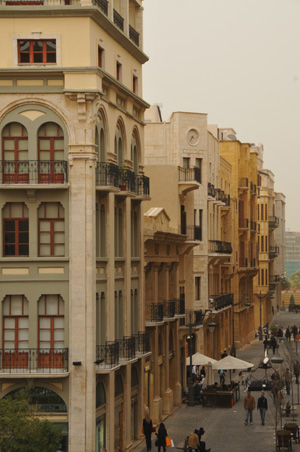
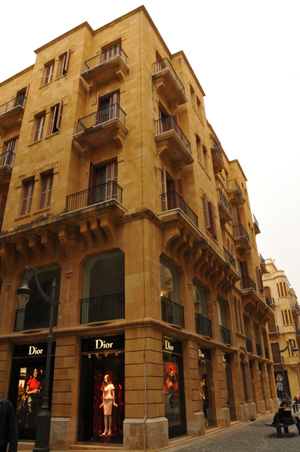
Beirut Central District, reconstruction by real estate company Solidere: one- to three- storey penthouse extensions attempt to imitate colonial architectural styles. Photographs by Styliane Philippou
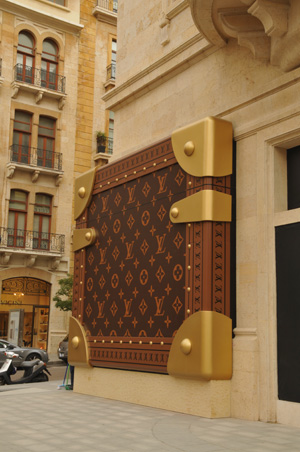
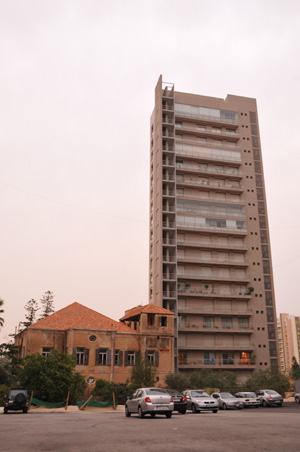
Beirut Central District, reconstruction by real estate company Solidere: luxury brands and high-rise residential developments rapidly colonize the urban core of the city. Photographs by Styliane Philippou
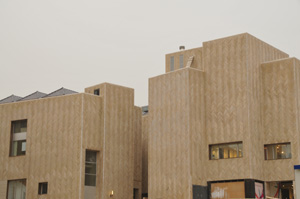
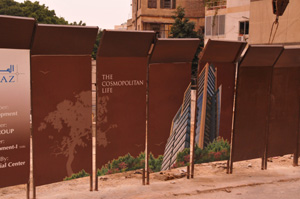
Rafael Moneo, Beirut Souks shopping centre, left, and a residential glitzy tower under construction promises 'The Cosmopolitan Life', right. Photographs by Styliane Philippou
'Solidere's architecture', says Yasmine Abbas, 'is an invention of the past, is clean, hygienic and dull denying the real Lebanese society that is struggling outside the new BCD's belt.'(14) The company proudly promotes its success 'in re-creating life in the heart of Beirut, making it once more the vibrant place where young and old from various countries and walks of life come together'.(15) The rhetoric of Solidere's chairman, Nasser Chammaa, is more revealing: he celebrates 'an urban phenomenon witnessed in today's cities, [where] entertainment, shopping and window-shopping, or the sheer pleasure of walking among beautiful buildings and landscaped areas, serve as relaxation to an active population and are part of the visitors' sightseeing experience.'(16) In fact, the bleak outcome of Solidere's unregulated, 'market-driven urbanism' and 'privatize[d] planning' may be summed up more accurately in terms of private privilege and collective impoverishment, social and economic exclusion, spatial segregation, historical amnesia, and architectural sterilization and falsification. The heart of the city once known as 'the Paris of the Middle East', has been deliberately transformed into a large, glitzy shopping mall colonized by all the luxury mega brands, serving wealthy insatiable consumers arriving in flashy vehicles with servants in tow. The vast majority of Beirut's citizens cannot afford to live there; pace Solidere's claims to the contrary, they as well as most of the city's tourists remain unconverted to the pleasures touted by the fourth largest Arab real estate developer.
On 10 May 2010, a BBC article quoted architect Assem Salam in its title: '"Ugly Beirut" struggles to survive peace'. Salam speaks of 'the [Lebanese] government's total disregard for public good'. The BBC also reported that the current Lebanese Prime Minister, Saad Hariri, son of Rafik Hariri 'has recently moved into his new palatial residence' in BCD.(17) In a context of weak administration and ailing state institutions, uncontrolled privatization and delegation of the reconstruction process to commercial developers dealt a fatal blow to the architectural heritage and social fabric, effectively to the memory, of the ancient city of Beirut. Only 85 kilometres north of Beirut, Tripoli appears to have been saved thanks to what its elected politicians perceive as its provincial character and backwardness. Its magnificent multi-layered historic urban fabric is inhabited by a vibrant community with a relaxed lifestyle. Tripoli's old streets, souks, hammams, mosques, madrassas, takiyyas and churches, Ottoman houses and caravansaries, schools, small factories, coffeehouses and beaches welcome and serve the city's residents, visitors and peddlers indiscriminately of their purchasing power. But economic marginalization means that much of Tripoli's historic fabric lies dilapidated and in urgent need of attention. A number of urban public spaces and historic structures, including the abandoned Orient Express railway station, are under serious threat. Development policies need to be formulated so that the city may preserve its treasures along with its memory, social fabric and livelihood, and so that it may meet the challenges of the future.
The Permanent International Fair of Tripoli cries out to be integrated in the life of the city. It represents a unique opportunity for public urban investment that would benefit all citizens rather than the privileged few and would provide true and meaningful prospects for interaction between different social groups. Its large, open, event-seeking spaces demand this kind of rehabilitation that would invite all citizens to lay claim to urban territory through their participation in public, cultural, non-commercial spectacles that strengthen a feeling of belonging to an urban community. The recreation of the fair as a public urban space, a site of true social and political integration, should aim to guarantee rights of citizenship for all Tripoli dwellers.

Oscar Niemeyer, Permanent International Fair, Tripoli. Photograph by Styliane Philippou
Notes
1 See Rowe, Peter G. and Hashim Sarkis, 'Introduction: Projecting Beirut'. Projecting Beirut: Episodes in the Construction and Reconstruction of a Modern City, ed. Peter Rowe and Hashim Sarkis (Munich, London and New York: Prestel), pp. 9-13.
2 Niemeyer, Oscar, 1963, 'Foire Internationale et Permanente du Liban à Tripoli', Architecture d'Aujourd'hui 33, no. 105 (December 1962-January 1963), pp. 96-101.
3 Niemeyer, Oscar, 1968, , Quase memórias, viagens: tempos de entusiasmo e revolta, 1961-1966 (Rio de Janeiro: Civilização Brasileira), p. 20.
4 Niemeyer, Oscar, 1962, 'Feira Internationale e Permanente do Líbano em Trípoli', Módulo 7, no. 30 (October), pp. 4-5.
5 Niemeyer, Oscar, 1962, 'Feira Internationale e Permanente do Líbano em Trípoli', Módulo 7, no. 30 (October), pp. 4-5.
6 Cited in Deknatel, Frederick, 2010, 'Beneath the Remains in Northern Lebanon', The National, 11 March, http://www.thenational.ae/apps/pbcs.dll/article?AID=/20100311/REVIEW/703119984/1193
7 Nardella, Bianca Maria and Yasmine Abbas, 'Beirut, Lebanon: Conservation and reconstruction in the Beirut Central District', http://web.mit.edu/akpia/www/AKPsite/4.239/beruit/beirut.html
In 1996, the investment bank Robert Fleming Securities published a report 'to provide background information about SOLIDERE'. The report informed international investors: 'The Fariri government proposed the private sector approach to the regeneration of the BCD; Hariri backed the cash subscription and he holds a substantial stake in the company. His party's sweeping win in the recent national elections represents a vote of confidence in his government's overall reconstruction policy - which was one of the main planks of the campaign. There has been political criticism of the BCD regeneration...The elections were for a four-year term of office. As long as the Hariri government stays in power, the reconstruction programme will continue to receive political support.' Robert Fleming Securities, September 1996, SOLIDERE: Beirut Restored, Opening up to Global Investors (London: Robert Fleming Securities), p. 16.
8 Salam, Assem, 1998, 'The Role of Government in Shaping the Built Environment'. In Projecting Beirut: Episodes in the Construction and Reconstruction of a Modern City, ed. Peter Rowe and Hashim Sarkis (Munich, London and New York: Prestel), pp. 131-33.
9 Nardella, Bianca Maria and Yasmine Abbas
10 Salam, Assem, pp. 131-33.
11 Fisk, Robert, 2001, 'Greed is destroying the beauty that was old Beirut', The Independent, 23 June.
12 http://www.solidere.com
13 Moneo, Rafael, 1998, 'The Souks of Beirut'. In Projecting Beirut: Episodes in the Construction and Reconstruction of a Modern City, p. 263.
14 Nardella, Bianca Maria and Yasmine Abbas
15 http://www.solidere.com
16 Chammaa, Nasser, 2004, 'Forward'. In Saliba, Robert and Solidere, 2004, Beirut City Center Recovery: The Foch-Allen By and Etoile Conservation Area (Göttingen: Steidl), p. 9. Solidere argues that 'At the heart of the world trend to privatize planning is a dual incentive. On the one hand, there is the common reaction to the failure of public-led urbanism in reaching the ideals of social equity and environmental quality; and, on the other hand, there is the renewed pursuit of a broader vision, related to late capitalism, to reconvert city cores into efficient corporate centers within a national, regional and global network.' Saliba, Robert and Solidere, p. 199.
17 Antelava, Natalia, 2010, '"Ugly Beirut" Struggles to Survive Peace', BBC News, Beirut, 10 May, http://news.bbc.co.uk/2/hi/middle_east/8665696.stm
Related articles:
- 360 Degrees Architecture ( 10 October, 2009 )
- Τhe Roots of the Industry of the Image ( 27 October, 2009 )
- Anish Kapoor: Non-objective Objects ( 26 November, 2009 )
- Love Thy Planet ( 28 December, 2009 )
- Europe’s Civilization under Threat ( 28 January, 2010 )
- Made of Stone and Water, for the Human Body ( 28 February, 2010 )
- test ( 01 January, 2010 )
- Bokja: ‘A Woman’s Affair’ ( 28 March, 2010 )
- Brasília from the Beginning, Fifty Years Ago ( 07 April, 2010 )
- Brasília, ‘capital of the highways and skyways’ ( 30 April, 2010 )
- Oscar Niemeyer’s Permanent International Fair in Tripoli ( 29 May, 2010 )
- Learning from Miami ( 10 July, 2010 )
- The Greatest Show on the Beach ( 08 August, 2010 )
- Oscar Niemeyer: Curves of Irreverence ( 28 March, 2011 )
- The Lizards of Djenné ( 26 September, 2010 )
- Transformed by Couture ( 29 October, 2010 )
- Another Athens Is Possible ( 02 December, 2010 )
- From Juan O’Gorman for Diego Rivera and Frida Kahlo ( 28 February, 2011 )
- Roberto Burle Marx: The Marvellous Art of Landscape Design ( 27 May, 2011 )
- The Danger that Lurks on this Side of the Gates ( 10 September, 2011 )
- Eduardo Souto de Moura ( 21 November, 2011 )
